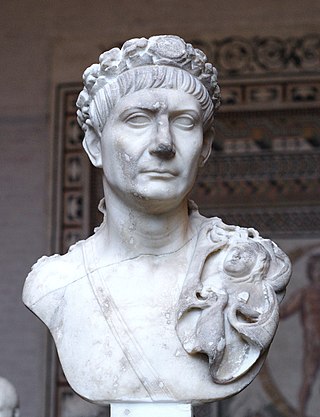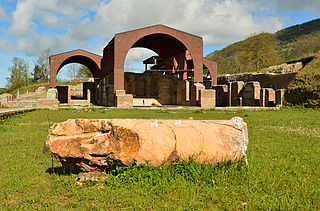Year 115 (CXV) was a common year starting on Monday of the Julian calendar. In the Roman Empire, it was known as the Year of the Consulship of Messalla and Vergilianus. The denomination 115 for this year has been used since the early medieval period, when the Anno Domini calendar era became the prevalent method in Europe for naming years.

The Praetorian Guard was the imperial guard of the Imperial Roman army that served various roles for the Roman emperor including being a bodyguard unit, counterintelligence, crowd control and gathering military intelligence.

The praefectus annonae, also called the praefectus rei frumentariae, was a Roman official charged with the supervision of the grain supply to the city of Rome. Under the Republic, the job was usually done by an aedile. However, in emergencies, or in times of extraordinary scarcity, someone would be elected to the office, and would take charge of supplying the entire city with provisions.
Sextus Attius Suburanus Aemilianus, commonly abbreviated as Suburanus, was a Roman eques who helped Trajan consolidate his position as emperor. Originally procurator of Gallia Belgica, Suburanus was appointed prefect of the Roman imperial bodyguard, known as the Praetorian Guard, in the year 98 and brought this important military unit under Trajan's control. For his achievement, at the end of his command of the Guard, Suburanus was adlected into the Roman senate inter praetores, then held the suffect consulship as the colleague of the consul posterior Quintus Articuleius Paetus in AD 101.

The gens Vibia was a plebeian family at ancient Rome. Although individuals named Vibius appear in history during the time of the Second Punic War, no members of this gens are found at Rome until the final century of the Republic. The first of the Vibii to obtain the consulship was Gaius Vibius Pansa in 43 BC, and from then until imperial times the Vibii regularly filled the highest offices of the Roman state. The emperors Trebonianus Gallus and Volusianus each claimed descent from the family.

Nerva was a Roman emperor from 96 to 98. Nerva became emperor when aged almost 66, after a lifetime of imperial service under Nero and the succeeding rulers of the Flavian dynasty. Under Nero, he was a member of the imperial entourage and played a vital part in exposing the Pisonian conspiracy of 65. Later, as a loyalist to the Flavians, he attained consulships in 71 and 90 during the reigns of Vespasian and Domitian, respectively. On 18 September 96, Domitian was assassinated in a palace conspiracy involving members of the Praetorian Guard and several of his freedmen. On the same day, Nerva was declared emperor by the Roman Senate. As the new ruler of the Roman Empire, he vowed to restore liberties which had been curtailed during the autocratic government of Domitian.

The gens Ulpia was a Roman family that rose to prominence during the first century AD. The gens is best known from the emperor Marcus Ulpius Trajanus, who reigned from AD 98 to 117. The Thirtieth Legion took its name, Ulpia, in his honor. The city of Serdica, modern day Sofia, was renamed as Ulpia Serdica.
The gens Rutilia was a plebeian family at ancient Rome. Members of this gens appear in history beginning in the second century BC. The first to obtain the consulship was Publius Rutilius Rufus in 105 BC.
Lucius Julius Ursus was a relative of the Flavian dynasty, who was originally one of the equites who held several imperial appointments, but afterwards was promoted to the Roman senate. He was suffect consul three times: once under Domitian and twice under Trajan.
Decimus Terentius Gentianus was a Roman senator of the 2nd century AD who held a number of offices in the imperial service, serving as suffect consul in 116 with Lucius Co[...] as his colleague. His origins may be in Gallia Narbonensis, and Gentianus may have been the son of Decimus Terentius Scaurianus, one of Trajan's generals.
Quintus Rammius Martialis was a Roman eques who held at least two important appointments during the reign of the emperors Trajan and Hadrian. His origins and family are not explicitly documented; Anthony Birley guesses he might be a native of Gallia Narbonensis, noting that a freedman Q. Rammius Q.l. Fronto is attested there.
Servius Sulpicius Similis was an eques of ancient Rome who held several imperial positions, both civil and military, under Trajan and Hadrian, culminating with praefectus or governor of Egypt from 107 to 112.
Marcus Aurelius Papirius Dionysius was a Roman eques and jurist who held a number of military and civilian positions during the reign of the Emperors Marcus Aurelius and his son Commodus, including praefectus annonae, or overseer of the grain rations for Rome.
Gaius Valerius Eudaemon was a Roman eques who held a number of military and civilian positions during the reigns of the Emperors Hadrian and Antoninus Pius, which includes praefectus of Roman Egypt. He is known as a close friend of the emperor Hadrian.
Gaius Tettius Africanus Cassianus Priscus was a Roman eques who held a number of appointments during the reigns of the emperor Vespasian and his sons. Pavis d'Escurac observes that Priscus is the only known eques to hold the ranks of both praefectus vigilum, praefectus annonae ; Priscus was also praefectus or governor of Roman Egypt.
Claudius Julianus was a Roman eques and jurist who held a number of military and civilian positions during the reign of the Emperor Septimius Severus, most importantly praefectus or governor of Roman Egypt. His relationship to other Claudii Juliani is unknown.
Tiberius Claudius Secundinus Lucius Statius Macedo was a Roman eques who held a number of appointments in the second century AD, the best known of which was praefectus annonae, or overseer of the food supply of Rome. Macedo is known only from a series of inscriptions.
Marcus Petronius Honoratus was a Roman eques who held a number of military and civilian positions during the reigns of the Emperors Hadrian and Antoninus Pius, which included praefectus annonae and praefectus or governor of Roman Egypt.
Quintus Marcius Dioga was a Roman eques who flourished during the reign of the emperor Septimius Severus and his sons. He was appointed to a series of imperial offices, including praefectus annonae,, and praefectus vigilum.

The Villa of Trajan was a palatial summer residence and hunting lodge of the ancient Roman Emperor Trajan, dating from the beginning of his reign. Its location, near the modern village of Arcinazzo, was, like many patrician villas, carefully chosen on high plateau at the foot of Monte Altuino and in a splendid wooded landscape to escape the summer heat of Rome. It is 2 km from the river Aniene which supplied Rome with water and on which Nero's villa at Subiaco is located about 12 km downstream. It occupies an area of about 5 hectares, much of which has yet to be excavated. Many fine room decorations have been recovered here, despite the mass robbing of expensive marbles in previous centuries.